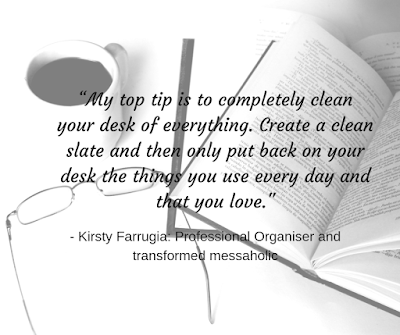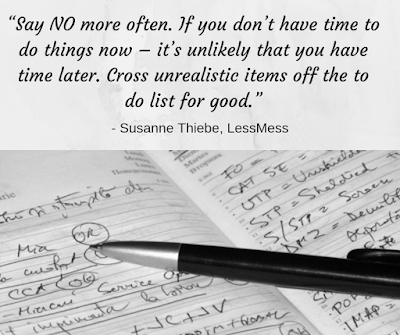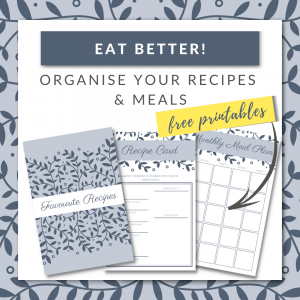When we think about “Spring Cleaning”, we often just think about cleaning our home, especially tackling the big cleaning jobs that we don’t do during the year. But there are lots of other areas you can apply a good old “Spring Clean” to your life. We sought the advice of some cleaning and organising experts to find out how to spring clean your office this spring. Here are some of their helpful tips:
1. Completely clear your desk
Rather than picking bits of pieces off your desk and dealing with them one at a time, Professional Organiser and transformed messaholic, Kirsty Farrugia says, “My top tip is to completely clean your desk of everything. Create a clean slate and then only put back on your desk the things you use every day and that you love (a picture of your loved ones). Deal with all other items, put filing away, put rubbish in the bin, give things back that belong to others and throw in the bin rubbish. This practice will help you maintain a clutter-free desk and help spark creativity”.
Jane Wilson, head of marketing and social at Melbourne branch of Fantastic Cleaners explains that “Every spring we have a de-cluttering organised in our entire office. Every employee is kindly asked to get rid of all the unnecessary items from their desks, such as old notebooks, pens that don’t work, various pieces of paper that are no longer relevant, and other similar items.”

By completely clearing your desk, this also allows you to easily perform the next step…
2. Wipe down your desk and office equipment
Wiping down your desk will get rid of any dust and left-over lunch crumbs, but don’t limit yourself to the desk – wipe down your phone, computer, keyboard and anything else on your desk that gets used regularly. Jane Wilson says that her team are “asked to wipe their desks and computers/phones with the products we provide,” but you can use wipes, dust clothes – whatever you have handy.
3. Organise, organise, organise
Completely clearing off your desk will allow you to see what pieces of paper need to be actioned, tossed, delegated, or filed. The key is to make a decision about everything you pick up – “Don’t just shift stuff from one area into another. Be realistic and know that things must go,” warns Susanne Thiebe from LessMess.
Don’t just stop at the physical files either. Use this time to also tackle your computer files. In Jane’s office, “Everyone also makes a small organising of their computer files, they get rid of everything they don’t need and every computer gets cleaned professionally,” which will enhance your work experience and efficiency when you can quickly find what you need.
Just be careful not to over organize your files/docs/emails, advises Susanne. After all, “Filing is about retrieving. If you know you are never going to read that information again, put it in the bin!!”
4. Tackle all areas of your office
Look around your office for other opportunities to clean and refresh your space – this applies to both small home offices and larger commercial offices alike. “Other spring cleaning routines we have is to have the carpets in the office washed, the windows as well, the office plants get re-potted and trimmed if needed, and all the common areas like kitchens, bathrooms and storage rooms get decluttered of old items, everything gets organised and dusted,” says Jane.
And don’t forget to “Get rid of excess furniture, paper, magazines, books etc,” Heather Gibson and Sara Hall from Finer Details Concierge & Organiser Services advise. Removing the larger items, especially furniture makes a remarkable difference in making your space feel less cluttered.
5. Spring clean your timetable
If you don’t have time to spring clean, maybe you need to spring clean your diary and To Do List. “Say NO more often. If you don’t have time to do things now – it’s unlikely that you have time later. Cross unrealistic items off the to do list for good,” says Susanne. Consider your overarching goals and vision. If there are things on your To Do list that don’t align with your bigger goals, carefully consider if they need to be on your list in the first place.

6. Set some ongoing “rules” for keeping your workspace organised
Heather Gibson and Sara Hall recommend the following “best practices” for ongoing maintenance:
1. Keep a clear desk – tidy at the end of each day
2. Allocate a time to deal with incoming mail – file, action or bin
3. Label storage areas so things are easily returned
4. Clearly mark disposal date on archives so you don’t end up keeping years of unnecessary paperwork
5. Use the “one-in one-out rule” – when insurance, licences and other annual renewals arrive in the mail, discard the old straight away
And finally, Susanne shares four motivating organising tips to remember:
1. Organising doesn’t come naturally to everyone, but “organising is a skill everyone can learn”.
2. “It’s more important to get it done than to get it done perfectly.”
3. “Start small – with one easy drawer or box.”
4. Celebrate your achievements
Be kind to yourself, spring cleaning and organising your space will take time, especially if you haven’t done it for a while. Block out some time in your diary to minimise distractions and get it done, put on some comfy clothes and great music and imagine how great it will feel when it’s done!
Thank you to our contributors for sharing their wise words:
1. Kirsty Farrugia: Professional Organiser and transformed messaholic.
Passionate about helping others to find space in their heads, hearts and homes, Kirsty wants to share with others the freedom that comes from living a decluttered life.
Owner of Feels Like Home Professional Organisers, and co-producer of popular podcast The Art of Decluttering, Kirsty is on a mission to help those who are too busy, too confused, too tired, too stressed or too overwhelmed to deal with their own clutter – working with clients to create order and make long-term improvements in all aspects of their lives.
Kirsty lives in Sydney, Australia with her uber-organised husband and her two gorgeous children.
2. Heather Gibson & Sara Hall, Finer Details Concierge & Organiser Services
Finer Details is a West Australian based Concierge & Organiser Service who have assisted local, interstate and overseas clients with their organisational needs. Sara and Heather are the owners of the longest operating Concierge business in Perth WA with a team of capable and dedicated employees. Learn more at www.finerdetails.com.au, or check them out on Facebook and Instagram.
3. Susanne Thiebe, LessMess
LessMess is a Professional Organising business specialising in family management and office organisation. Susanne (Thiebe) has been running her business LessMess since 2006. She trained in Germany and has an engineering degree in Interior Architecture. She is married and mother to three boys. She is an accredited Expert Professional Organiser and founding member of the Institute of Professional Organisers (IOPO). Susanne writes a regular blog as well as a fortnightly newsletter that contain organising tips, interesting web links and snippets of her families’ personal journey to live a life less stressful and more fulfilling. Learn more at www.lessmess.com.au, or connect on Facebook and Twitter (lessmess).
4. Jane Wilson, Fantastic Cleaners, Melbourne
Jane is a business manager, a mum and a blogger. She is originally from London, but moved to Melbourne more than 5 years ago. Jane manages the Melbourne branch of Fantastic Cleaners as the head of marketing and social. Jane also has a small personal blog, Modern Housewives, where she post articles on different topics, like home improvement, cool DIY and gardening projects, tips on raising children and more.
Want more tips like this? Subscribe to our newsletter here…












